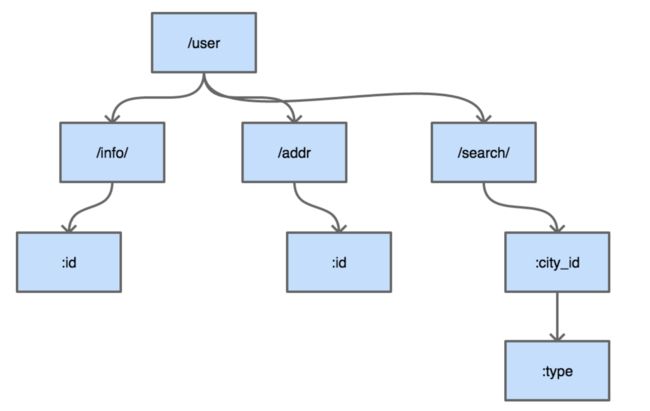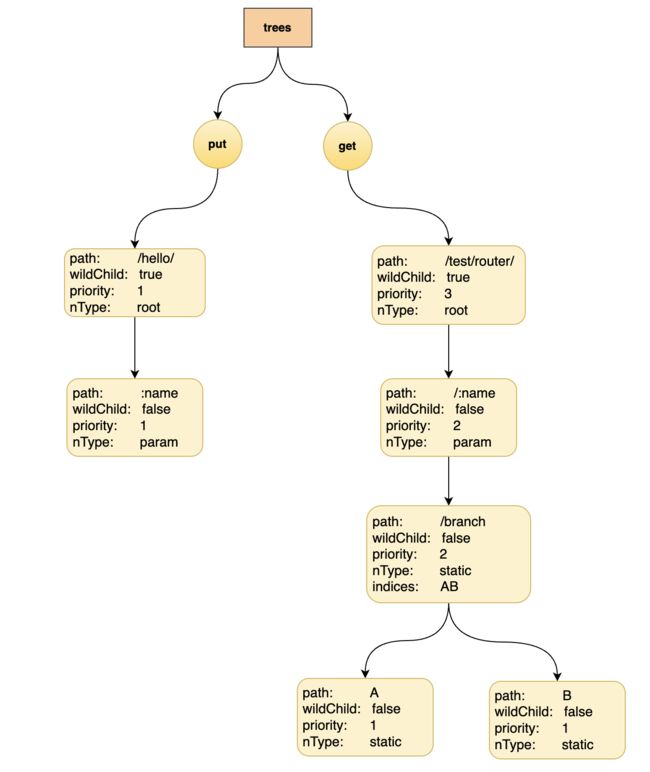深入浅出关于go web的请求路由
文章目录
- 前言
- 一、是否一定要用框架来使用路由?
- 二、httprouter
-
- 2.1 httprouter介绍
- 2.2 httprouter原理
- 2.3 路由冲突情况
- 三、gin中的路由
- 总结
前言
最近重新接触Go语言以及对应框架,想借此机会深入下对应部分。
并分享一下最近学的过程很喜欢的一句话:
The limits of my language mean the limits of my world. by Ludwig Wittgenstein
我的语言之局限,即我的世界之局限。
一、是否一定要用框架来使用路由?
- 首先来介绍一下什么是路由。
路由是指确定请求应该由哪个处理程序处理的过程。在 Web 开发中,路由用于将请求映射到相应的处理程序或控制器。路由的种类通常包括以下几种:
- 静态路由: 静态路由是指将特定的 URL 路径映射到特定的处理程序或控制器的路由。这种路由是最基本的路由类型,通常用于处理固定的 URL 请求。例如一个简单的GET请求: /test/router
- 动态路由: 动态路由是指根据 URL 中的参数或模式进行匹配的路由。例如,可以使用动态路由来处理包含变量或参数的 URL 请求,以便根据请求的内容返回相应的结果。例如一个简单的GET请求: /test/:id
因为 Go 的 net/http 包提供了基础的路由函数组合与丰富的功能函数。所以在社区里流行一种用 Go 编写 API 不需要框架的观点,在我们看来,如果你的项目的路由在个位数、URI 固定且不通过 URI 来传递参数,那么确实使用官方库也就足够。
Go 的 Web 框架大致可以分为这么两类:
- Router 框架
- MVC 类框架
- 在框架的选择上,大多数情况下都是依照个人的喜好和公司的技术栈。例如公司有很多技术人员是 PHP 出身转go,那么他们一般会喜欢用 beego 这样的框架(典型的mvc架构),对于有些公司可能更喜欢轻量的框架那么则会使用gin,当然像字节这种内部则会去选择性能更高的kiteX作为web框架。
- 但如果公司有很多 C 程序员,那么他们的想法可能是越简单越好。比如很多大厂的 C 程序员甚至可能都会去用 C 语言去写很小的 CGI 程序,他们可能本身并没有什么意愿去学习 MVC 或者更复杂的 Web 框架,他们需要的只是一个非常简单的路由(甚至连路由都不需要,只需要一个基础的 HTTP 协议处理库来帮他省掉没什么意思的体力劳动)。
- 而对于一个简单的web服务利用官方库来编写也只需要短短的几行代码足矣:
package main
import (...)
func echo(wr http.ResponseWriter, r *http.Request) {
msg, err := ioutil.ReadAll(r.Body)
if err != nil {
wr.Write([]byte("echo error"))
return
}
writeLen, err := wr.Write(msg)
if err != nil || writeLen != len(msg) {
log.Println(err, "write len:", writeLen)
}
}
func main() {
http.HandleFunc("/", echo)
err := http.ListenAndServe(":8080", nil)
if err != nil {
log.Fatal(err)
}
}
这个例子是为了说明在 Go 中写一个 HTTP 协议的小程序有多么简单。如果你面临的情况比较复杂,例如几十个接口的企业级应用,直接用 net/http 库就显得不太合适了。
例如来看早期开源社区中一个 Kafka 监控项目Burrow中的做法:
func NewHttpServer(app *ApplicationContext) (*HttpServer, error) {
...
server.mux.HandleFunc("/", handleDefault)
server.mux.HandleFunc("/burrow/admin", handleAdmin)
server.mux.Handle("/v2/kafka", appHandler{server.app, handleClusterList})
server.mux.Handle("/v2/kafka/", appHandler{server.app, handleKafka})
server.mux.Handle("/v2/zookeeper", appHandler{server.app, handleClusterList})
...
}
看上去很简短,但是我们再深入进去:
func handleKafka(app *ApplicationContext, w http.ResponseWriter, r *http.Request) (int, string) {
pathParts := strings.Split(r.URL.Path[1:], "/")
if _, ok := app.Config.Kafka[pathParts[2]]; !ok {
return makeErrorResponse(http.StatusNotFound, "cluster not found", w, r)
}
if pathParts[2] == "" {
// Allow a trailing / on requests
return handleClusterList(app, w, r)
}
if (len(pathParts) == 3) || (pathParts[3] == "") {
return handleClusterDetail(app, w, r, pathParts[2])
}
switch pathParts[3] {
case "consumer":
switch {
case r.Method == "DELETE":
switch {
case (len(pathParts) == 5) || (pathParts[5] == ""):
return handleConsumerDrop(app, w, r, pathParts[2], pathParts[4])
default:
return makeErrorResponse(http.StatusMethodNotAllowed, "request method not supported", w, r)
}
case r.Method == "GET":
switch {
case (len(pathParts) == 4) || (pathParts[4] == ""):
return handleConsumerList(app, w, r, pathParts[2])
case (len(pathParts) == 5) || (pathParts[5] == ""):
// Consumer detail - list of consumer streams/hosts? Can be config info later
return makeErrorResponse(http.StatusNotFound, "unknown API call", w, r)
case pathParts[5] == "topic":
switch {
case (len(pathParts) == 6) || (pathParts[6] == ""):
return handleConsumerTopicList(app, w, r, pathParts[2], pathParts[4])
case (len(pathParts) == 7) || (pathParts[7] == ""):
return handleConsumerTopicDetail(app, w, r, pathParts[2], pathParts[4], pathParts[6])
}
case pathParts[5] == "status":
return handleConsumerStatus(app, w, r, pathParts[2], pathParts[4], false)
case pathParts[5] == "lag":
return handleConsumerStatus(app, w, r, pathParts[2], pathParts[4], true)
}
default:
return makeErrorResponse(http.StatusMethodNotAllowed, "request method not supported", w, r)
}
case "topic":
switch {
case r.Method != "GET":
return makeErrorResponse(http.StatusMethodNotAllowed, "request method not supported", w, r)
case (len(pathParts) == 4) || (pathParts[4] == ""):
return handleBrokerTopicList(app, w, r, pathParts[2])
case (len(pathParts) == 5) || (pathParts[5] == ""):
return handleBrokerTopicDetail(app, w, r, pathParts[2], pathParts[4])
}
case "offsets":
// Reserving this endpoint to implement later
return makeErrorResponse(http.StatusNotFound, "unknown API call", w, r)
}
// If we fell through, return a 404
return makeErrorResponse(http.StatusNotFound, "unknown API call", w, r)
}
这会发现这其中的这个handler扩展的比较复杂,这个原因是因为默认的 net/http 包中的 mux 不支持带参数的路由,所以 Burrow 这个项目使用了非常蹩脚的字符串 Split 和乱七八糟的 switch case 来达到自己的目的,但却让本来应该很集中的路由管理逻辑变得复杂,散落在系统的各处,难以维护和管理。但如今Burrow项目的路由已经重构为使用httpRouter。感兴趣的小伙伴可以自己再去看看相关源码:Burrow
type Coordinator struct {
// App is a pointer to the application context. This stores the channel to the storage subsystem
App *protocol.ApplicationContext
// Log is a logger that has been configured for this module to use. Normally, this means it has been set up with
// fields that are appropriate to identify this coordinator
Log *zap.Logger
router *httprouter.Router
servers map[string]*http.Server
theCert map[string]string
theKey map[string]string
}
包括如今的web框架的路由部分也是由httprouter改造而成的,后续也会继续深入讲下这部分。
二、httprouter
在常见的 Web 框架中,router 是必备的组件。Go 语言圈子里 router 也时常被称为 http 的 multiplexer。如果开发 Web 系统对路径中带参数没什么兴趣的话,用 http 标准库中的 mux 就可以。而对于最近新起的Restful的api设计风格则基本重度依赖路径参数:
GET /repos/:owner/:repo/comments/:id/reactions
POST /projects/:project_id/columns
PUT /user/starred/:owner/:repo
DELETE /user/starred/:owner/:repo
如果我们的系统也想要这样的 URI 设计,使用之前标准库的 mux 显然就力不从心了。而这时候一般就会使用之前提到的httprouter。
2.1 httprouter介绍
地址:
https://github.com/julienschmidt/httprouter
https://godoc.org/github.com/julienschmidt/httprouter
因为 httprouter 中使用的是显式匹配,所以在设计路由的时候需要规避一些会导致路由冲突的情况,例如:
#冲突的情况:
GET /user/info/:name
GET /user/:id
#不冲突的情况:
GET /user/info/:name
POST /user/:id
简单来讲的话,如果两个路由拥有一致的 http 方法 (指 GET、POST、PUT、DELETE) 和请求路径前缀,且在某个位置出现了 A 路由是 带动态的参数(/:id),B 路由则是普通字符串,那么就会发生路由冲突。路由冲突会在初始化阶段直接 panic,如:
panic: wildcard route ':id' conflicts with existing children in path '/user/:id'
goroutine 1 [running]:
github.com/cch123/httprouter.(*node).insertChild(0xc4200801e0, 0xc42004fc01, 0x126b177, 0x3, 0x126b171, 0x9, 0x127b668)
/Users/caochunhui/go_work/src/github.com/cch123/httprouter/tree.go:256 +0x841
github.com/cch123/httprouter.(*node).addRoute(0xc4200801e0, 0x126b171, 0x9, 0x127b668)
/Users/caochunhui/go_work/src/github.com/cch123/httprouter/tree.go:221 +0x22a
github.com/cch123/httprouter.(*Router).Handle(0xc42004ff38, 0x126a39b, 0x3, 0x126b171, 0x9, 0x127b668)
/Users/caochunhui/go_work/src/github.com/cch123/httprouter/router.go:262 +0xc3
github.com/cch123/httprouter.(*Router).GET(0xc42004ff38, 0x126b171, 0x9, 0x127b668)
/Users/caochunhui/go_work/src/github.com/cch123/httprouter/router.go:193 +0x5e
main.main()
/Users/caochunhui/test/go_web/httprouter_learn2.go:18 +0xaf
exit status 2
除支持路径中的 动态参数之外,httprouter 还可以支持 * 号来进行通配,不过 * 号开头的参数只能放在路由的结尾,例如下面这样:
Pattern: /src/*filepath
/src/ filepath = ""
/src/somefile.go filepath = "somefile.go"
/src/subdir/somefile.go filepath = "subdir/somefile.go"
而这种场景主要是为了: httprouter 来做简单的 HTTP 静态文件服务器。
除了正常情况下的路由支持,httprouter 也支持对一些特殊情况下的回调函数进行定制,例如 404 的时候:
r := httprouter.New()
r.NotFound = http.HandlerFunc(func(w http.ResponseWriter, r *http.Request) {
w.Write([]byte("oh no, not found"))
})
或者内部 panic 的时候:
r := httprouter.New()
在r.PanicHandler = func(w http.ResponseWriter, r *http.Request, c interface{}) {
log.Printf("Recovering from panic, Reason: %#v", c.(error))
w.WriteHeader(http.StatusInternalServerError)
w.Write([]byte(c.(error).Error()))
}
2.2 httprouter原理
httprouter的使用在一开始时会使用New进行注册。对应函数为:
func New() *Router {
return &Router{
RedirectTrailingSlash: true,
RedirectFixedPath: true,
HandleMethodNotAllowed: true,
HandleOPTIONS: true,
}
}
这四个参数的分别的作用为:
- RedirectTrailingSlash: 指定是否重定向带有尾部斜杠的 URL。如果设置为 true,则当用户访问没有斜杠结尾的 URL 时,httprouter 会将其重定向到带有斜杠结尾的 URL。例如,将 “/path” 重定向到 “/path/”。
- RedirectFixedPath: 指定是否重定向固定路径。如果设置为 true,则当用户访问具有固定路径的 URL 时,httprouter 会将其重定向到正确的固定路径。这对于确保 URL 的一致性和规范性非常有用。
- HandleMethodNotAllowed: 指定是否处理不允许的 HTTP 方法。如果设置为 true,则当用户使用不允许的 HTTP 方法访问 URL 时,httprouter 会返回 “405 Method Not Allowed” 错误。
- HandleOPTIONS: 指定是否处理 OPTIONS 方法。如果设置为 true,则当用户使用 OPTIONS 方法访问 URL 时,httprouter 会返回允许的 HTTP 方法列表。
更详细的可以参考源码注释。
除此之外Router中还有一个很重要的字段:
type Router struct {
// ...
trees map[string]*node
// ...
}
而这个字段则涉及到了底层的数据结构实现,阅读httprouter的源码注释可以简单知道:
Package httprouter is a trie based high performance HTTP request router.
-
因此httprouter的底层是用压缩字典树实现的,属于字典树的一个变种,在继续介绍这块之前简单做一个知识的补充:
-
字典树即前缀树(Trie树),又称单词查找树或键树,是一种树形结构,是一种哈希树的变种。典型应用是用于统计和排序大量的字符串(但不仅限于字符串),所以经常被搜索引擎系统用于文本词频统计。
它的优点是: 利用字符串的公共前缀来减少查询时间,最大限度地减少无谓的字符串比较。
以下是一颗字典树的生成,分别插入app、apple、abcd、user、use、job。
字典树的生成
- 而压缩字典树(Radix)也很好理解,因为字典树的节点粒度是以一个字母,而像路由这种有规律的字符串完全可以把节点粒度加粗,减少了不必要的节点层级减少存储空间压缩字符,并且由于深度的降低,搜索的速度也会相对应的加快。例如做成如下这种形式::

因此上述的Map其实存放的key 即为 HTTP 1.1 的 RFC 中定义的各种方法,而node则为各个方法下的root节点。GET、HEAD、OPTIONS、POST、PUT、PATCH、DELETE
因此每一种方法对应的都是一棵独立的压缩字典树,这些树彼此之间不共享数据。
- 对于node结构体:
type node struct {
path string
indices string
wildChild bool
nType nodeType
priority uint32
children []*node
handle Handle
}
参数分别代表的意思:
-
path: 表示当前节点对应的路径中的字符串。例如,如果节点对应的路径是 “/user/:id”,那么 path 字段的值就是 “:id”。
-
indices: 一个字符串,用于快速查找子节点。它包含了当前节点的所有子节点的第一个字符。为了加快路由匹配的速度。
-
wildChild: 一个布尔值,表示子节点是否为参数节点,即 wildcard node,或者说像 “:id” 这种类型的节点。如果子节点是参数节点,则 wildChild 为 true,否则为 false。
-
nType: 表示节点的类型,是一个枚举类型。它可以表示静态节点、参数节点或通配符节点等不同类型的节点。
-
priority: 一个无符号整数,用于确定节点的优先级。这有助于在路由匹配时确定最佳匹配项。
-
children: 一个指向子节点的指针数组。它包含了当前节点的所有子节点。
-
handle: 表示与当前节点关联的处理函数(handler)。当路由匹配到当前节点时,将调用与之关联的处理函数来处理请求。
-
对于nodeType:
const (
static nodeType = iota // 非根节点的普通字符串节点
root // 根节点
param // 参数节点 如:id
catchAll // 通配符节点 如:*anyway
)
而对于添加一个路由的过程基本在源码tree.go的addRoute的func中。大概得过程补充在注释中:
// 增加路由并且配置节点handle,因为中间的变量没有加锁,所以不保证并发安全,如children之间的优先级
func (n *node) addRoute(path string, handle Handle) {
fullPath := path
n.priority++
// 空树的情况下插入一个root节点
if n.path == "" && n.indices == "" {
n.insertChild(path, fullPath, handle)
n.nType = root
return
}
walk:
for {
// 找到最长的公共前缀。
// 并且公共前缀中不会包含 no ':' or '*',因为公共前缀key不能包含这两个字符,遇到了则直接continue
i := longestCommonPrefix(path, n.path)
// 如果最长公共前缀小于 path 的长度,那么说明 path 无法与当前节点路径匹配,需要进行边的分裂
// 例如:n 的路径是 "/user/profile",而当前需要插入的路径是 "/user/posts"
if i < len(n.path) {
child := node{
path: n.path[i:],
wildChild: n.wildChild,
nType: static,
indices: n.indices,
children: n.children,
handle: n.handle,
priority: n.priority - 1,
}
n.children = []*node{&child}
// []byte for proper unicode char conversion, see #65
n.indices = string([]byte{n.path[i]})
n.path = path[:i]
n.handle = nil
n.wildChild = false
}
// 处理剩下非公共前缀的部分
if i < len(path) {
path = path[i:]
// 如果当前节点有通配符(wildChild),则会检查通配符是否匹配,如果匹配则继续向下匹配,否则会出现通配符冲突的情况,并抛出异常。
if n.wildChild {
n = n.children[0]
n.priority++
// Check if the wildcard matches
if len(path) >= len(n.path) && n.path == path[:len(n.path)] &&
// Adding a child to a catchAll is not possible
n.nType != catchAll &&
// Check for longer wildcard, e.g. :name and :names
(len(n.path) >= len(path) || path[len(n.path)] == '/') {
continue walk
} else {
// Wildcard conflict
pathSeg := path
if n.nType != catchAll {
pathSeg = strings.SplitN(pathSeg, "/", 2)[0]
}
prefix := fullPath[:strings.Index(fullPath, pathSeg)] + n.path
panic("'" + pathSeg +
"' in new path '" + fullPath +
"' conflicts with existing wildcard '" + n.path +
"' in existing prefix '" + prefix +
"'")
}
}
idxc := path[0]
// 如果当前节点是参数类型(param)并且路径中的下一个字符是 '/',并且当前节点只有一个子节点,则会继续向下匹配。
if n.nType == param && idxc == '/' && len(n.children) == 1 {
n = n.children[0]
n.priority++
continue walk
}
// 检查是否存在与路径中的下一个字符相匹配的子节点,如果有则继续向下匹配,否则会插入新的子节点来处理剩余的路径部分。
for i, c := range []byte(n.indices) {
if c == idxc {
i = n.incrementChildPrio(i)
n = n.children[i]
continue walk
}
}
if idxc != ':' && idxc != '*' {
// []byte for proper unicode char conversion, see #65
n.indices += string([]byte{idxc})
child := &node{}
n.children = append(n.children, child)
n.incrementChildPrio(len(n.indices) - 1)
n = child
}
n.insertChild(path, fullPath, handle)
return
}
// Otherwise add handle to current node
if n.handle != nil {
panic("a handle is already registered for path '" + fullPath + "'")
}
n.handle = handle
return
}
}
接下来以一个实际的案例,创建6个路由:
func Index(w http.ResponseWriter, r *http.Request, _ httprouter.Params) {
fmt.Fprint(w, "Welcome!\n")
}
func Hello(w http.ResponseWriter, r *http.Request, ps httprouter.Params) {
fmt.Fprintf(w, "hello, %s!\n", ps.ByName("name"))
}
func main() {
router := httprouter.New()
router.PUT("/hello/:name", Hello)
router.GET("/test/router/", Hello)
router.GET("/test/router/:name/branchA", Hello)
router.GET("/test/router/:name/branchB", Hello)
router.GET("status", Hello)
router.GET("searcher", Hello)
log.Fatal(http.ListenAndServe(":8080", router))
}
也因为底层数据结构的原因,所以为了不让树的深度过深,在初始化时会对参数的数量进行限制,所以在路由中的参数数目不能超过 255,否则会导致 httprouter 无法识别后续的参数。
2.3 路由冲突情况
所以路由本身只有字符串的情况下,不会发生任何冲突。只有当路由中含有 wildcard(类似 :id)或者 catchAll 的情况下才可能冲突。这在2.1中也提到过。
而子节点的冲突处理很简单,分几种情况:
- 在插入 wildcard 节点时,父节点的 children 数组非空且 wildChild 被设置为 false。
例如:GET /user/getAll 和 GET /user/:id/getAddr,或者 GET /user/*aaa 和 GET /user/:id。
- 在插入 wildcard 节点时,父节点的 children 数组非空且 wildChild 被设置为 true,但该父节点的 wildcard 子节点要插入的 wildcard 名字不一样。
例如:GET /user/:id/info 和 GET /user/:name/info。
- 在插入 catchAll 节点时,父节点的 children 非空。
例如:GET /src/abc 和 GET /src/*filename,或者 GET /src/:id 和 GET /src/*filename。
- 在插入 static 节点时,父节点的 wildChild 字段被设置为 true。
- 在插入 static 节点时,父节点的 children 非空,且子节点 nType 为 catchAll。
三、gin中的路由
之前提到过现在Star数最高的web框架gin中的router中的很多核心实现很多基于httprouter中的,具体的可以去gin项目中的tree.go文件看对应部分,这里主要讲一下gin的路由除此之外额外实现了什么。
gin项目地址链接
在gin进行初始化的时候,可以看到初始化的路由时它其实是初始化了一个路由组,而使用router对应的GET\PUT等方法时则是复用了这个默认的路由组,这里已经略过不相干代码。
r := gin.Default()
func Default() *Engine {
...
engine := New()
...
}
func New() *Engine {
...
engine := &Engine{
RouterGroup: RouterGroup{
Handlers: nil,
basePath: "/",
root: true,
},
...
...
}
// RouterGroup is used internally to configure router, a RouterGroup is associated with
// a prefix and an array of handlers (middleware).
type RouterGroup struct {
Handlers HandlersChain
basePath string
engine *Engine
root bool
}
因此可以看出gin在底层实现上比普通的httprouter多出了一个路由组的概念。这个路由组的作用主要能对api进行分组授权。例如正常的业务逻辑很多需要登录授权,有的接口需要这个鉴权,有些则可以不用,这个时候就可以利用路由组的概念的去进行分组。
- 这里用一个最简单的例子去使用:
// 创建路由组
authorized := r.Group("/admin",func(c *gin.Context) {
// 在此处编写验证用户权限的逻辑
// 如果用户未经授权,则可以使用 c.Abort() 中止请求并返回相应的错误信息
})
// 在路由组上添加需要授权的路径
authorized.GET("/dashboard", dashboardHandler)
authorized.POST("/settings", settingsHandler)
当然group源码中也可以传入一连串的handlers去进行前置的处理业务逻辑。
// Group creates a new router group. You should add all the routes that have common middlewares or the same path prefix.
// For example, all the routes that use a common middleware for authorization could be grouped.
func (group *RouterGroup) Group(relativePath string, handlers ...HandlerFunc) *RouterGroup {
return &RouterGroup{
Handlers: group.combineHandlers(handlers),
basePath: group.calculateAbsolutePath(relativePath),
engine: group.engine,
}
}
对于正常的使用一个
而这个RouterGroup正如注释提到的RouterGroup is used internally to configure router,只是配置对应的路由,对应真正的路由树的结构还是在对应的engine的trees中的。与我们之前看的httprouter差不多
type methodTrees []methodTree
func New() *Engine {
...
trees methodTrees
...
}
所以总的来说,RouterGroup与Engine的关系是这样
因此不管通过Engine实例对象可以创建多个routergroup,然后创建出来的routergroup都会再重新绑定上engine,而借助结构体的正交性组合的特点,新构建出来的组的路由组还可以继续使用engine继续创造新的路由组,而不管横向创造多少个,或者纵向创建多少个,改变的始终是唯一那个engine的路由树。而纵向创建group这种方式,则是gin中创建嵌套路由的使用方式。
package main
import (
"github.com/gin-gonic/gin"
)
func main() {
router := gin.Default()
// 创建父级路由组
v1 := router.Group("/v1")
{
// 在父级路由组中创建子级路由组
users := v1.Group("/users")
{
// 子级路由组中的路由
users.GET("/", func(c *gin.Context) {
c.JSON(200, gin.H{"message": "Get all users"})
})
users.POST("/", func(c *gin.Context) {
c.JSON(200, gin.H{"message": "Create a new user"})
})
}
}
router.Run(":8080")
}
总结
重新接触go,看了些书并深入学习了下组件/框架源码,还是和几年前写6.824时只是使用go理解有些不同,特别是刚从熟悉的java转过来,也去看了些对应的方面,觉得go这种静态类型的语言还是有很多可以学习的地方,也写了些对应的笔记(后续有时间再结合起来发…),这次看gin的框架时也更加的体会到关于go函数式编程的魅力。后续大概还会继续深入看gin的框架源码,然后希望能坚持到看完hertz。
如有不足,欢迎指正~





